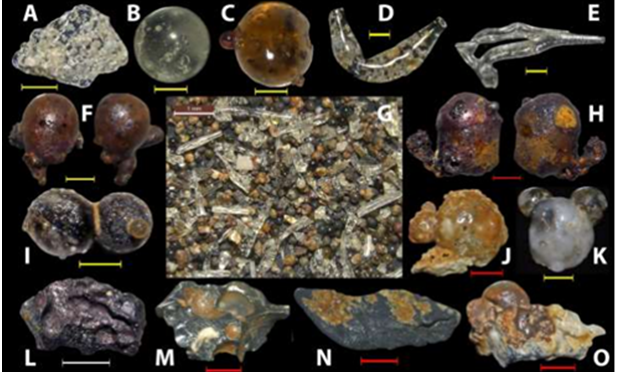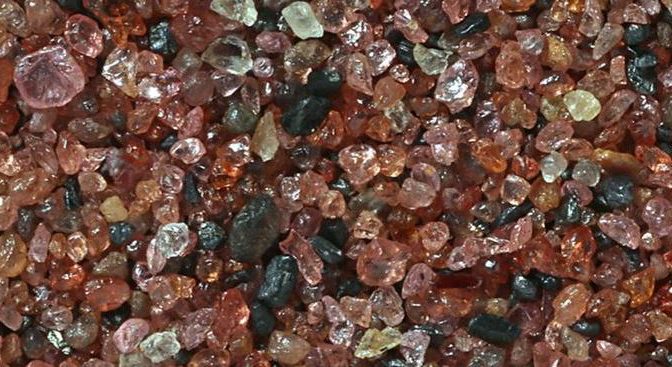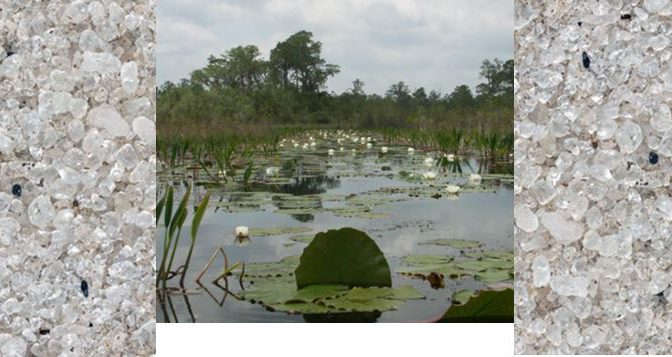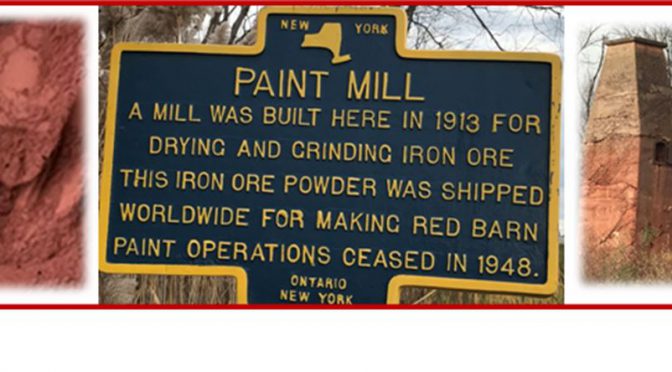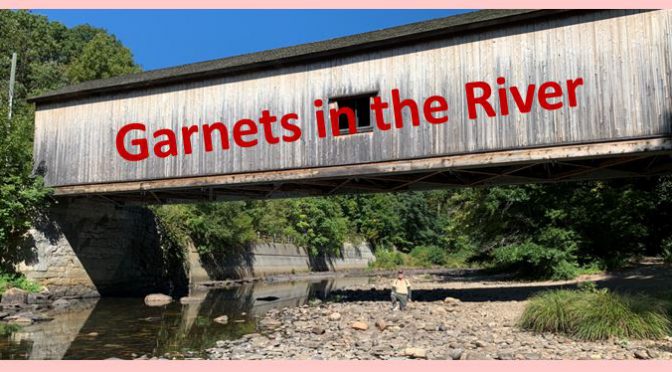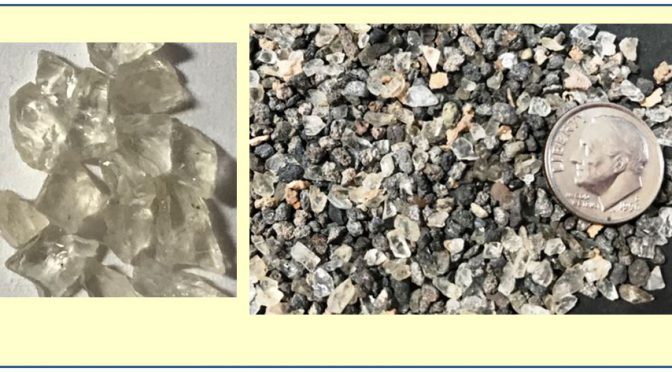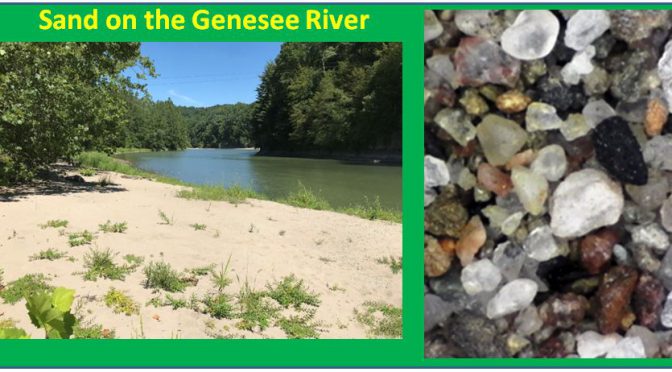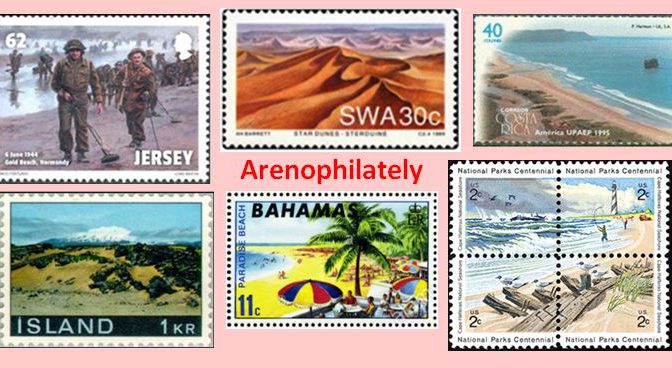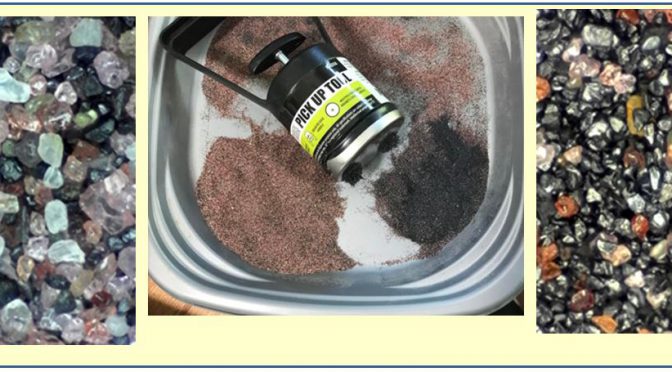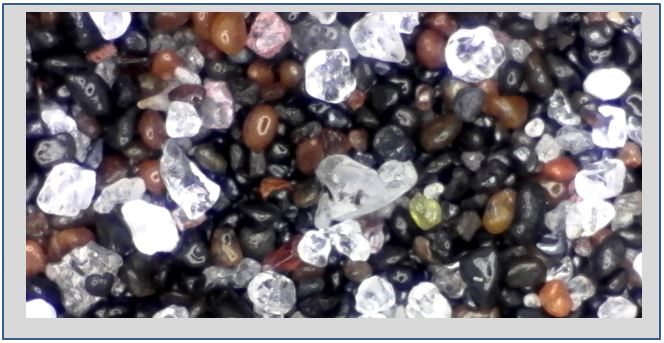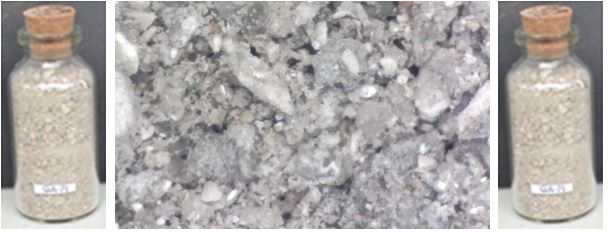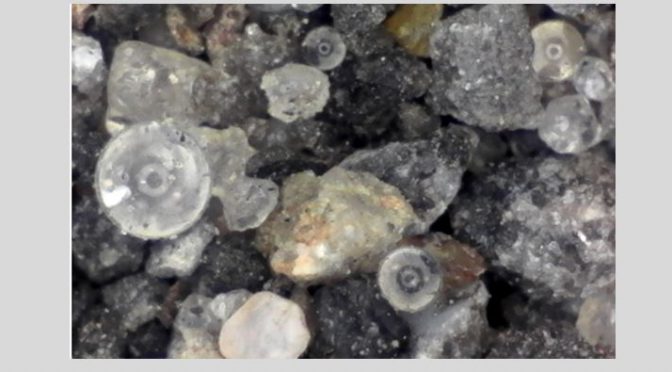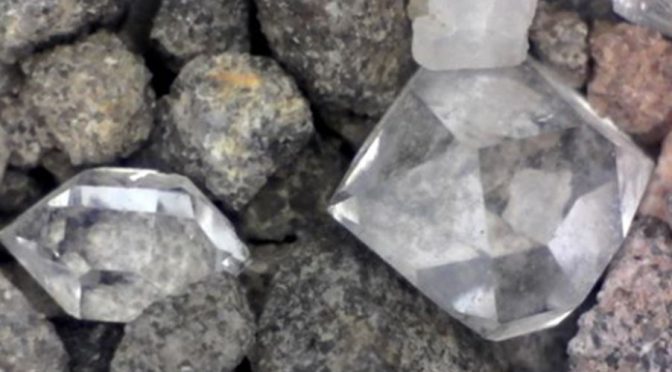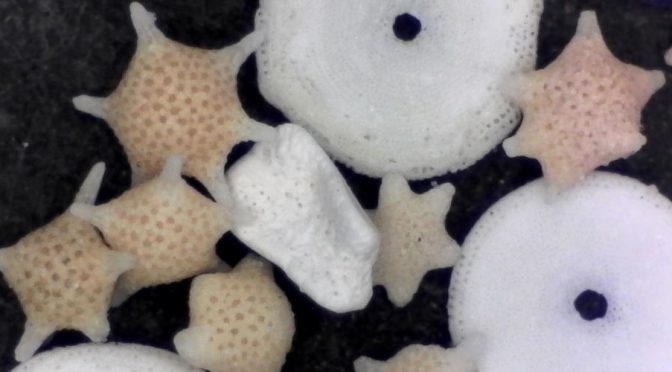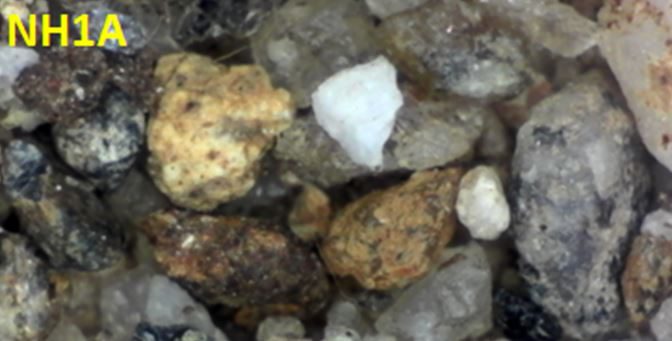On August 6th, 1945, the United States detonated a 5-ton nuclear weapon over Hiroshima, Japan. The result helped end WW2 in the Pacific Arena as Japan surrendered less than one month later, but it was devastating to the city of Hiroshima and its immediate surroundings. Approximately 100,000 Japanese perished in the blast and about 5 square miles of the city were obliterated as ground temperature reached above 1800⁰ C in the firestorm that followed.
Continue reading Sand from HiroshimaCategory Archives: Arenophilia
A Sea of Garnet Sand
In early 2020, I was comfortably sitting in my man cave planning a September trip to collect beach sands along the coastline of southern New England. While cruising along the shoreline using Google Maps satellite images I spotted a bright red patch of beach near Madison, Connecticut. Zooming in, there seemed no doubt. The beach sand there is red. Could the dominant mineral in that patch of beach be garnet? If it is, this could be a highlight stop along the trip. Continue reading A Sea of Garnet Sand
Sand from a Swamp
In September, I met Leo Kenney at Plum Island in Massachusetts and later at his home northwest of Boston. And yes, we traded sands. One that I came home with intrigued me. It was labeled Floyd’s Island, Okefenokee Swamp, Georgia. From all appearances, it was fine-medium-grained quartz-rich sand, much like one you might find on an ocean beach. But this one was from a swamp. I needed to know more. Continue reading Sand from a Swamp
Ontario Center Paint Mill
I had driven by the sign in the title box dozens of times and often wondered what might be behind the cattails and railroad tracks in Ontario Center. Motivated by the visit to the old Wolcott furnace last month and by the possibility of obtaining a hematite “sand” sample I decided to stop on my next excursion that took me through western Wayne County on Route 104. Continue reading Ontario Center Paint Mill
Garnets in the Salmon River
Article from November 2020 Wayne County Gem and Mineral Club Newsletter
While Linda Schmidtgall liked the garnets weathering from a schist roadcut in Tolland, I believe I have had more fun playing with the garnet-bearing sand recovered from below the Comstock Covered Bridge in East Hampton, CT. Both make great sand samples and both sourced their garnets from the Devonian Littleton schist, a mica- and garnet-rich metamorphic rock formed during the Acadian orogeny (mountain-building event) ~375-325 million years ago. The Acadian event was the third of four orogenies along eastern North America that collectively created the Appalachian Mountains and surrounding terrains.
Utah sunstone
This month I was working with “sand” that was actually too large to be technically called sand. Rather the grains were granules, the finest size fraction of gravel. I had obtained 200ml samples of four different gravels from Ed Tindell, a Texas collector, trading him gravels from northeast locations I had visited. One of my new samples was from Sunstone Knoll in Millard County, Utah. The gravel had accumulated in the alluvium shed from adjacent Sunstone Knoll. Ed had size-sieved a large sample and the material he sent me was from the 1/16” to 1/8” (1.7-3.2mm) size range, bridging the upper limit of sand, but mostly fine gravel or granules (see chart at the end of the article).
Collecting a River
The Genesee River ends in my hometown of Rochester, New York completing a 160-mile journey from Potter County, PA. During its course, the river falls some 2250’. Several notable waterfalls mark its journey north.
If you read my blog, you might know that I have become an arenophile, or more simply, a sand collector. In that endeavor, I have started to collect sand along the path of the Genesee River as it crosses across mostly rural farmlands and suburban communities. Rochester is the only major city graced by its presence. The surficial geology is mostly glacial deposits (moraines, outwash, etc.) of highly variable composition, but the river also cuts into Paleozoic sedimentary rock below that is Pennsylvanian to Ordovician in age, a rock record of about 140 million years. The major waterfalls mark resistant limestone and dolostone units; intervening shale units less resistant to erosion generate gentler topography.
Arenophilately
I wrote this article for the Spring 2020 issue of Philagems, the newsletter of an International Group of stamp collectors with an interest in “Gems. Minerals, and Jewelry on Stamps.”
I have a confession to make. I have become an arenophile. Fortunately, in many places it is not illegal (unless trespassing while doing it), and it should not be harmful to my health. I would say it is generally not contagious, but I did catch it a year ago when introduced to the hobby at a local rock club meeting. I did not realize I was hooked until the summer of 2019. While collecting minerals on trips in Maine and Michigan, I kept my eyes open for sands to collect and proceeded to fill quart freezer bags at a few dozen locations along lakes, rivers, and from glacial deposits. You see an arenophile is a lover of sand. The word is derived from the Latin “arena” (sand) and the Greek ”phil” (love).
But this is a philatelic newsletter, what does this have to do with stamps, and more specifically minerals on stamps? Well, sand is nothing more than a pile of mineral grains, and there are certainly many worldwide postage stamps depicting sand. The most popular thematic stamps depicting sand are, of course, beaches, like several of those depicted in the header. But there are also river sands, land sand, and wind-blown sand dunes such as those on this South-West Africa (now Namibia) stamp, also in the header. Why not collect and display sands from various beaches next to stamps showing these beaches? And why not call it arenophilately? Would this not be a reasonable offshoot of a group specializing in minerals on stamps? There are actually some very unique and beautiful minerals hidden in the sands of the world. Continue reading Arenophilately
Heavy Sands, Hamlin, NY
Last July I collected one of my first sand samples, locating garnet-magnetite sands in a small cove east of Hamlin State Beach on Lake Ontario. It turned out to be one of the more popular trade sands I have and although I still had some I decided to venture out again this year. I was curious whether the accumulation would still be there, virtually one year later. Perhaps last winter’s storms removed the heavy sands and I might have to search anew. But they were right where they had been a year ago and even more stratified.
A Phosphatic Sand Beach
Some sand can be appreciated purely for its color and appearance. Other times the shapes of the grains or the overall texture of the sand makes it stand out when compared to others. Of course, a unique geology or an unusual mineral component can help to distinguish a sand also. Occasionally a beach comes along where the sand displays all three attributes. I consider the phosphatic sands from Caspersen Beach in Venice, Florida to be such a sand.
Kaolinite
My only “sand” sample of kaolinite, shown in the title box above, is gray. It is from a kaolin quarry in Gordon, Georgia and came to me courtesy of a mail trade with the Georgia Mineralogy Society. The kaolinite in central Georgia is Late Cretaceous in age (~70 million years old) and is sedimentary in origin, derived from the weathering of igneous rocks. This region across Georgia may be better known to fossil collectors seeking terrestrial mammal bones and teeth from the overlying Eocene Formations (Rhinehart, et. al. 2019).
Urban Sand
While I was piling up steps on my Health App, I was also thinking about all those good sands I was missing by not traveling about the northeast (or even beyond). And one fine day, I decided to drop into a small creek that crosses East Ave just north of Pittsford and sample sand that was visible through all the new growth. I knew it would not be spectacular, but it did look like a nice sand bar had developed just off the road where the creek made a sharp jog. And heck, why not?
My First Sand?
It has now been almost a year since I started actively collecting and trading sand. I collected somewhere near 100 different sands last summer and fall during mineral trips or on day outings around western New York. And during the winter I have traded some of those for others. I think my total count exceeded 750 earlier this month when trade packages arrived from Maryland and California.
With that backdrop, imagine my surprise last January when my wife dug out three peanut butter jars from the corner of the garage labeled “Monahans Sandhills, 1995”. They were full of tan quartz-dominated sand! She had collected the quartz-rich sand when we had lived in Midland, Texas, some 50 miles to the east. She had earmarked them for our three sons and pretty much forgotten them (the sands, not our sons!).
Ancient Glacial Loess
The global pandemic has all of us re-thinking our daily lives. I had to cancel (or at best postpone) a May trip to collect sands from New England beaches. With my time at home, I chose to walk about my neighborhood. While doing this I was always alert to opportunities to collect sand. They would certainly not be as exotic as Cape Cod or the creeks in the Berkshires of western MA, but perhaps they could still be interesting.
One location I wanted to sample was in a small town park close to my home which contained a nice half-mile trail through the woods. My home sits atop glacial lake sediments (or dunes created when the glacial lake emptied). I have dug for fine sand there (Sand Times, vol 1 #1, pg. 2). The surface geology map of western NY suggests this park might be outside the lake boundaries. Might the sand there be different? Continue reading Ancient Glacial Loess
Golf Course Sand
It is mid-April and I should be planning field trips, perhaps even taking my first of the season. But like everyone else I am planted at home, watching the first responders and others attempting to defeat this virus. But what else have I been doing? Well, first off, the yard and all the rock gardens may look as good as they ever have by the time it is warm enough for growth to begin. And I have been taking walks, lots of walks: short walks, intermediate walks, and long walks. I am wearing my walking shoes out. I know every nook and cranny of my neighborhood.
On one of those long walks in late March, I was thinking about the New England beach trip for sand collecting that I was not going to be able to undertake. And I happened to be walking along the edge of Oak Hill Golf Course in my home town of Pittsford, NY. I saw sand, lots of sand. Of course, I know that golf course sand is not local, nor is it 100% natural. Nevertheless, I did wonder what it looked like and where it might come from.
It Was Meant To Be
I should have known. It was only a matter of time before I would return to my roots and become a sand collector again. It goes back to December of 1976. I was a senior at Lehigh University with one semester left before earning a B.S. in Geology. I wanted to do a Senior Research project during my final semester. Having just completed a course in Sedimentology, Professor Bobb Carson suggested I study the heavy minerals present in beach sand. Perhaps I could compare the composition of heavy minerals present in the tidal zone with those high in the dunes. Perhaps aeolian sands would have a different heavy mineral content than those in the tidal zone. Why not, I thought. It could be fun.
Herkimer sand
On April 1st, Wayne County Gem and Mineral Club was planning to open its 2020 field season with a visit to Ace of Diamonds in Middleville, NY. The coronavirus has intervened with our plans and this annual rite of passage is not possible this year, but we can spend time enjoying the Herkimers we have collected on past trips.
For most folks these are small- or modest-sized crystals collected from the piles of rock the owners have hauled from their active, off-limits, mining area behind the hill. And I certainly spend time digging and breaking large rocks in search of centimeter or inch-sized diamonds. But, when the club visited last October, just before the site went into its annual hibernation, I did something a bit different.
Blue Sand from California
Sand comes in virtually all colors, however, as my collection grew this past year, I was not adding much blue to my collection. In fact, I really did not have a blue sand until a very unique and interesting sand appeared in the trade box that Bill Beiriger sent me in January. It was inauspiciously labeled as fine, blue-gray sand from a location 12 miles east of Livermore, California. The GPS coordinates Bill provided placed the site closer to Tracy, California and in the Diablo Mountain foothills.
The Sands of Guam
This winter I have been an active sand trader, acquiring sand from around the world in exchange for some I collected on our club trips last summer. I could fill a book with stories and pictures of these sands and their locations. However, for now, I have selected one location and two sands to highlight. But first, a little history and a bit of geology.
Bumpus Brook Sand
It seems many sand collections focus on ocean beaches. This is understandable. The settings provide gorgeous destinations and the sands can be wonderfully textured. I like beach sands, but don’t want to short-change river sands in my collection. Unlike beaches, where provenance is hard, or even impossible, to define, river sands offer an interesting opportunity as their provenance can be determined. Naturally, this is not easy if your sample comes from the Mississippi River delta but consider the other extreme, a sand sample from a mountain stream.
Last July, I traversed the White Mountains of northern New Hampshire on a return trip from Maine. Just off Route 2 north of the Presidential Range is a short, 3 mile (5 kilometers) drainage between two ridges on the steep north slope of Mt. Madison. It is called Bumpus Brook and a small bridge along Pinkham B Road allows access. Much of the creek’s sediment load is larger than sand size with cobbles and small boulders strewn along the flowing stream. But, at bends on both sides of the bridge, there are sand bars that can be sampled.
